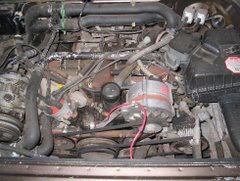 Mike Parker, the instructor I imported from the West Coast after seeing a video account of last year's commuter car conversion course, was born and raised in Turlock CA. He went to college at San Francisco State, and his post-college career as a manufacturing and quality control engineer took him to Brazil, Cincinnati, Oklahoma City, and Boulder before he returned to his birthplace in 1987. During this time he also acquired experience in machine shops, ran his own sheet metal shop, and self-published a book of poems.
Mike Parker, the instructor I imported from the West Coast after seeing a video account of last year's commuter car conversion course, was born and raised in Turlock CA. He went to college at San Francisco State, and his post-college career as a manufacturing and quality control engineer took him to Brazil, Cincinnati, Oklahoma City, and Boulder before he returned to his birthplace in 1987. During this time he also acquired experience in machine shops, ran his own sheet metal shop, and self-published a book of poems.Upon returning to California after 21 years Mike noticed that the smog in the San Joaquin Valley had increased noticeably. He began to question the internal combustion engine and soon purchased a 1980 Lectric Leopard. Lectric Leopards were early production electric cars, converted by U.S. ElectriCar in Massachusetts from Renault LeCars which were shipped sans ICE from Canada. (There's a good rundown on the Lectric Leopard here). In 1994 he took a class with Mike Brown, author of the 1993 manual Convert It, which is our textbook for the course. Over the last two summers he has co-taught two commuter car conversion classes in Turlock and Encinitas with San Diego auto shop teacher Abran Quevedo, and this past April he offered a private conversion workshop on weekends in Turlock.
Mike is concerned with homelessness as a social issue, and when he's not teaching at the Turlock Adult School he can be found offering support and companionship to Turlock's homeless population. He is particularly interested in transitional housing projects for the working homeless where the homeless run the housing.
 Bill Kirkpatrick grew up in Cheltenham, PA and graduated from Eastern Vo-tech in 1971. He has always had a passion for anything mechanical. His first car was a 1961 Volkswagen Beetle; he swapped in a Porsche engine to improve its performance. Bill worked for VW and Porsche prior to getting into teaching in 1982. When I asked him what attracted him to teaching, he credited some of his European mentors at VW, who taught him well and patiently and inspired him to do the same for high school students.
Bill Kirkpatrick grew up in Cheltenham, PA and graduated from Eastern Vo-tech in 1971. He has always had a passion for anything mechanical. His first car was a 1961 Volkswagen Beetle; he swapped in a Porsche engine to improve its performance. Bill worked for VW and Porsche prior to getting into teaching in 1982. When I asked him what attracted him to teaching, he credited some of his European mentors at VW, who taught him well and patiently and inspired him to do the same for high school students.Bill is indeed a patient and inspiring teacher, and his students and fellow faculty members at NMTCC speak warmly and admiringly of him. In addition to teaching, Bill helps place students in new car dealerships through the industry organization AYES, or Automotive Youth Educational System. Bill is unassuming and quick to give credit to others; when I found out that he was originally responsible for shepherding NMTCC's automotive education program through AYES' rigorous certification process, he immediately noted that that process requires both school board and administrative support. "Without that," he points out, "we wouldn't be able to do what we're doing right now."
Bill and his students participated 3 years running in electric go-kart competitions sponsored by PECO, and he has had an interest in EV's since helping rehabilitate a small Citicar belonging to a neighbor. In keeping with the environmental commitments he and his wife Margaret have made (such as purchasing wind energy and buying an annual share in an organic farm, or CSA), Bill would love to have an electric vehicle as their second car.
Bill's classroom at NMTCC is decorated with clippings from his work with Habitat for Humanity. He and his family have spent summer vacations working in in Taos, NM, in Honduras, and most recently in post-Katrina New Orleans, where one of his daughters just completed a tour with Americorps. Bill and Margaret have three children and one grandchild.
Next -- back to the workshop, Day 7!





No comments:
Post a Comment